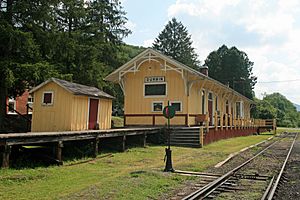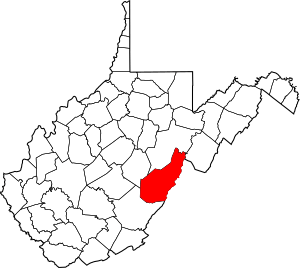Pocahontas County, West Virginia facts for kids
Quick facts for kids
Pocahontas County
|
|
|---|---|

The quaint station in Durbin, used for scenic trips by Durbin and Greenbrier Valley Railroad
|
|

Location within the U.S. state of West Virginia
|
|
 West Virginia's location within the U.S. |
|
| Country | |
| State | |
| Founded | December 21, 1821 |
| Named for | Pocahontas |
| Seat | Marlinton |
| Largest town | Marlinton |
| Area | |
| • Total | 942 sq mi (2,440 km2) |
| • Land | 940 sq mi (2,400 km2) |
| • Water | 1.5 sq mi (4 km2) 0.2%% |
| Population
(2010)
|
|
| • Total | 8,719 |
| • Estimate
(2019)
|
8,247 |
| • Density | 9.256/sq mi (3.5737/km2) |
| Time zone | UTC−5 (Eastern) |
| • Summer (DST) | UTC−4 (EDT) |
| Congressional district | 3rd |
Pocahontas County is a county located in the U.S. state of West Virginia. As of the 2010 census, the population was 8,719. Its county seat is Marlinton. The county was established in 1821. It is named after the daughter of the Powhatan chief of the Native Americans in the United States from Jamestown, Virginia. She married an English settler and their children became ancestors of many of the First Families of Virginia.
Pocahontas County is the home to the Green Bank Observatory and is part of the National Radio Quiet Zone.
Contents
History
When Andrew Lewis, early American pioneer, soldier, surveyor, and soldier from Virginia, came to survey one of the land grants for the Greenbrier Company in 1751, he found Jacob Marlin and Stephen Sewell living where Marlinton is found today. They had come from Frederick, Maryland, in 1749 and are considered the first settlers west of the Alleghenies. They built their original cabin where Marlin Run met Knapp’s Creek but Lewis found Sewell living in a large hollow sycamore tree near the cabin in what is now the area between Eighth and Ninth Avenues between Eighth and Ninth Streets.
The move Westward by settlers was not met well by the Indians as this was one of their many favored hunting areas. A treaty of 1758 confirmed the land west of the Allegheny Mountains to the Indians and forbidding any of his Majesty’s subjects to settle or hunt.
As the white settlers encroached onto the Indian land, there were many raids and massacres reported. After the Revolution, the Indian squabbles quieted and the settlers’ land claims were secured in an orderly manner.
In June 1863, West Virginia became the 35th state of the Union. Although part of Virginia at the time, the two areas differed culturally and pioneering individuals traditionally settled the western portion, while a slave-holding aristocratic society developed in the eastern portion. When Virginia seceded from the Union in 1861, the residents of the western counties, few of whom owned slaves, decided to stay with the Union.
The railroads came late to Pocahontas County as building rails over the mountains was not only a tedious job, but an expensive job. It was not until 1899 that construction began but after that, the task moved with startling speed. The 1900 census of the county indicates that many Europeans came to the region to build the railroads.
Commercial timbering quickly began upon completion of the railroads, including a large mill owned by the West Virginia Pulp & Paper Company (now MeadWestvaco) at Cass. By the end of 1920, dozens of small railroading towns dotted the landscape along the Chesapeake & Ohio Railway line.
Geography
According to the U.S. Census Bureau, the county has a total area of 942 square miles (2,440 km2), of which 940 square miles (2,400 km2) is land and 1.5 square miles (3.9 km2) (0.2%) is water. It is the third-largest county in West Virginia by area.
The highest point is Thorny Flat on Cheat Mountain in the northwestern part of the county, elevation 4848 feet (1478 m).
Birthplace of rivers
The county is the site of the headwaters for eight rivers: Cherry River, Cranberry River, Elk River, Gauley River, Greenbrier River, Tygart Valley River, Williams River, and Shavers Fork of the Cheat River. The Monongahela National Forest protects much of the river headwaters, thereby helping to ensure improved downstream water quality.
Major highways
 U.S. Highway 219
U.S. Highway 219 U.S. Highway 250
U.S. Highway 250 West Virginia Route 28
West Virginia Route 28 West Virginia Route 39
West Virginia Route 39 West Virginia Route 55
West Virginia Route 55 West Virginia Route 66
West Virginia Route 66 West Virginia Route 84
West Virginia Route 84 West Virginia Route 92
West Virginia Route 92
National protected areas
- Monongahela National Forest (part)
- Cranberry Glades Botanical Area
- Gaudineer Scenic Area
Demographics
| Historical population | |||
|---|---|---|---|
| Census | Pop. | %± | |
| 1830 | 2,542 | — | |
| 1840 | 2,922 | 14.9% | |
| 1850 | 3,598 | 23.1% | |
| 1860 | 3,958 | 10.0% | |
| 1870 | 4,069 | 2.8% | |
| 1880 | 5,561 | 36.7% | |
| 1890 | 6,814 | 22.5% | |
| 1900 | 8,570 | 25.8% | |
| 1910 | 14,740 | 72.0% | |
| 1920 | 15,002 | 1.8% | |
| 1930 | 14,555 | −3.0% | |
| 1940 | 13,906 | −4.5% | |
| 1950 | 12,480 | −10.3% | |
| 1960 | 10,136 | −18.8% | |
| 1970 | 8,870 | −12.5% | |
| 1980 | 9,919 | 11.8% | |
| 1990 | 9,008 | −9.2% | |
| 2000 | 9,131 | 1.4% | |
| 2010 | 8,719 | −4.5% | |
| 2019 (est.) | 8,247 | −5.4% | |
| U.S. Decennial Census 1790–1960 1900–1990 1990–2000 2010–2019 |
|||
2010 census
As of the 2010 United States Census, there were 8,719 people, 3,758 households, and 2,373 families living in the county. The population density was 9.3 inhabitants per square mile (3.6/km2). There were 8,847 housing units at an average density of 9.4 per square mile (3.6/km2). The racial makeup of the county was 97.8% white, 0.7% black or African American, 0.2% American Indian, 0.2% from other races, and 1.0% from two or more races. Those of Hispanic or Latino origin made up 0.8% of the population. In terms of ancestry, 23.0% were German, 20.1% were Irish, 12.7% were English, 9.9% were American, 5.2% were Scottish, and 5.1% were Dutch.
Of the 3,758 households, 24.1% had children under the age of 18 living with them, 49.1% were married couples living together, 9.1% had a female householder with no husband present, 36.9% were non-families, and 31.3% of all households were made up of individuals. The average household size was 2.24 and the average family size was 2.75. The median age was 47.1 years.
The median income for a household in the county was $32,161 and the median income for a family was $40,906. Males had a median income of $32,411 versus $25,321 for females. The per capita income for the county was $19,763. About 11.8% of families and 15.3% of the population were below the poverty line, including 20.6% of those under age 18 and 11.7% of those age 65 or over.
Communities
Towns
- Town of Durbin
- Town of Hillsboro
- Town of Marlinton (county seat)
Census-designated places
Unincorporated communities
Economy
Tourism
As of 2008, there were approximately 30,000 out-of-towners who own property in Pocahontas County. The tourism industry has continued to be one of the county's largest economic industries. The main tourist attraction is Snowshoe Mountain, which attracts thousands of visitors every summer and winter.
Notable people
- Pearl S. Buck, author, was born in Hillsboro.
- W. E. Blackhurst, author
- William Luther Pierce, leader of the National Alliance lived on property near Mill Point.
See also
 In Spanish: Condado de Pocahontas (Virginia Occidental) para niños
In Spanish: Condado de Pocahontas (Virginia Occidental) para niños


